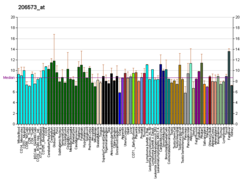KvLQT3
KvLQT3| KCNQ3 | |||||||||||||||||||||||||
|---|---|---|---|---|---|---|---|---|---|---|---|---|---|---|---|---|---|---|---|---|---|---|---|---|---|
| 식별자 | |||||||||||||||||||||||||
| 별칭 | KCNQ3, BFNC2, EBN2, KV7.3, 칼륨 전압 게이트 채널 서브 패밀리 Q 멤버 3 | ||||||||||||||||||||||||
| 외부 ID | OMIM: 602232 MGI: 1336181 호몰로진: 20949 GeneCard: KCNQ3 | ||||||||||||||||||||||||
| |||||||||||||||||||||||||
| |||||||||||||||||||||||||
| |||||||||||||||||||||||||
| |||||||||||||||||||||||||
| 직교체 | |||||||||||||||||||||||||
| 종 | 인간 | 마우스 | |||||||||||||||||||||||
| 엔트레스 | |||||||||||||||||||||||||
| 앙상블 | |||||||||||||||||||||||||
| 유니프로트 | |||||||||||||||||||||||||
| RefSeq(mRNA) | |||||||||||||||||||||||||
| RefSeq(단백질) | |||||||||||||||||||||||||
| 위치(UCSC) | Chr 8: 132.12 – 132.48Mb | Cr 15: 65.86 – 66.16Mb | |||||||||||||||||||||||
| PubMed 검색 | [3] | [4] | |||||||||||||||||||||||
| 위키다타 | |||||||||||||||||||||||||
| |||||||||||||||||||||||||
K7v.3(KvLQT3)은 유전자 KCNQ3에 의해 암호화된 칼륨 채널 단백질이다.[5]
그것은 양성 가족성 신생아 간질과 관련이 있다.
M 채널은 서서히 활성화되고 비활성화된 칼륨 채널로, 뉴런의 흥분성 조절에 중요한 역할을 한다.M 채널은 이 유전자에 의해 인코딩된 단백질과 KCNQ2와 KCNQ5 유전자에 의해 인코딩된 두 개의 관련 단백질 중 하나의 결합에 의해 형성되며, 두 가지 모두 일체형 막 단백질이다.M 채널 전류는 M1 무스카린 아세틸콜린 수용체에 의해 억제되며, 새로운 항경련제인 레티가빈에 의해 활성화된다.이 유전자의 결함은 간질, 양성 신생아 2형(EBN2)이라고도 알려진 양성 가족 신생아 경련 2형(BFNC2)의 원인이다.[5]
상호작용
KvLQT3는 KCNQ5와 상호작용하는 것으로 나타났다.[6]
참조
- ^ a b c GRCh38: 앙상블 릴리스 89: ENSG00000184156 - 앙상블, 2017년 5월
- ^ a b c GRCm38: 앙상블 릴리스 89: ENSMUSG000056258 - 앙상블, 2017년 5월
- ^ "Human PubMed Reference:". National Center for Biotechnology Information, U.S. National Library of Medicine.
- ^ "Mouse PubMed Reference:". National Center for Biotechnology Information, U.S. National Library of Medicine.
- ^ a b "Entrez Gene: KCNQ3 potassium voltage-gated channel, KQT-like subfamily, member 3".
- ^ Yus-Nájera, E; Muñoz A; Salvador N; Jensen B S; Rasmussen H B; Defelipe J; Villarroel A (2003). "Localization of KCNQ5 in the normal and epileptic human temporal neocortex and hippocampal formation". Neuroscience. 120 (2): 353–64. doi:10.1016/S0306-4522(03)00321-X. ISSN 0306-4522. PMID 12890507. S2CID 38381189.
추가 읽기
- Gutman GA, Chandy KG, Grissmer S, et al. (2006). "International Union of Pharmacology. LIII. Nomenclature and molecular relationships of voltage-gated potassium channels". Pharmacol. Rev. 57 (4): 473–508. doi:10.1124/pr.57.4.10. PMID 16382104. S2CID 219195192.
- Ryan SG, Wiznitzer M, Hollman C, et al. (1991). "Benign familial neonatal convulsions: evidence for clinical and genetic heterogeneity". Ann. Neurol. 29 (5): 469–73. doi:10.1002/ana.410290504. PMID 1859177. S2CID 25424485.
- Lewis TB, Leach RJ, Ward K, et al. (1993). "Genetic heterogeneity in benign familial neonatal convulsions: identification of a new locus on chromosome 8q". Am. J. Hum. Genet. 53 (3): 670–5. PMC 1682419. PMID 8102508.
- Charlier C, Singh NA, Ryan SG, et al. (1998). "A pore mutation in a novel KQT-like potassium channel gene in an idiopathic epilepsy family". Nat. Genet. 18 (1): 53–5. doi:10.1038/ng0198-53. PMID 9425900. S2CID 10437379.
- Yang WP, Levesque PC, Little WA, et al. (1998). "Functional expression of two KvLQT1-related potassium channels responsible for an inherited idiopathic epilepsy". J. Biol. Chem. 273 (31): 19419–23. doi:10.1074/jbc.273.31.19419. PMID 9677360.
- Wang HS, Pan Z, Shi W, et al. (1998). "KCNQ2 and KCNQ3 potassium channel subunits: molecular correlates of the M-channel". Science. 282 (5395): 1890–3. Bibcode:1998Sci...282.1890W. doi:10.1126/science.282.5395.1890. PMID 9836639.
- Schroeder BC, Kubisch C, Stein V, Jentsch TJ (1999). "Moderate loss of function of cyclic-AMP-modulated KCNQ2/KCNQ3 K+ channels causes epilepsy". Nature. 396 (6712): 687–90. Bibcode:1998Natur.396..687S. doi:10.1038/25367. PMID 9872318. S2CID 4417442.
- Kubisch C, Schroeder BC, Friedrich T, et al. (1999). "KCNQ4, a novel potassium channel expressed in sensory outer hair cells, is mutated in dominant deafness". Cell. 96 (3): 437–46. doi:10.1016/S0092-8674(00)80556-5. PMID 10025409.
- Selyanko AA, Hadley JK, Wood IC, et al. (1999). "Two types of K(+) channel subunit, Erg1 and KCNQ2/3, contribute to the M-like current in a mammalian neuronal cell" (PDF). J. Neurosci. 19 (18): 7742–56. doi:10.1523/JNEUROSCI.19-18-07742.1999. PMC 6782456. PMID 10479678.
- Shapiro MS, Roche JP, Kaftan EJ, et al. (2000). "Reconstitution of muscarinic modulation of the KCNQ2/KCNQ3 K(+) channels that underlie the neuronal M current". J. Neurosci. 20 (5): 1710–21. doi:10.1523/JNEUROSCI.20-05-01710.2000. PMC 6772928. PMID 10684873.
- Rundfeldt C, Netzer R (2000). "The novel anticonvulsant retigabine activates M-currents in Chinese hamster ovary-cells tranfected with human KCNQ2/3 subunits". Neurosci. Lett. 282 (1–2): 73–6. doi:10.1016/S0304-3940(00)00866-1. PMID 10713399. S2CID 28431577.
- Selyanko AA, Hadley JK, Wood IC, et al. (2000). "Inhibition of KCNQ1-4 potassium channels expressed in mammalian cells via M1 muscarinic acetylcholine receptors". J. Physiol. 522 Pt 3 (3): 349–55. doi:10.1111/j.1469-7793.2000.t01-2-00349.x. PMC 2269765. PMID 10713961.
- Cooper EC, Aldape KD, Abosch A, et al. (2000). "Colocalization and coassembly of two human brain M-type potassium channel subunits that are mutated in epilepsy". Proc. Natl. Acad. Sci. U.S.A. 97 (9): 4914–9. Bibcode:2000PNAS...97.4914C. doi:10.1073/pnas.090092797. PMC 18332. PMID 10781098.
- Schwake M, Pusch M, Kharkovets T, Jentsch TJ (2000). "Surface expression and single channel properties of KCNQ2/KCNQ3, M-type K+ channels involved in epilepsy". J. Biol. Chem. 275 (18): 13343–8. doi:10.1074/jbc.275.18.13343. PMID 10788442.
- Hirose S, Zenri F, Akiyoshi H, et al. (2000). "A novel mutation of KCNQ3 (c.925T-->C) in a Japanese family with benign familial neonatal convulsions". Ann. Neurol. 47 (6): 822–6. doi:10.1002/1531-8249(200006)47:6<822::AID-ANA19>3.0.CO;2-X. PMID 10852552.
- Main MJ, Cryan JE, Dupere JR, et al. (2000). "Modulation of KCNQ2/3 potassium channels by the novel anticonvulsant retigabine". Mol. Pharmacol. 58 (2): 253–62. doi:10.1124/mol.58.2.253. PMID 10908292.
- Wickenden AD, Yu W, Zou A, et al. (2000). "Retigabine, a novel anti-convulsant, enhances activation of KCNQ2/Q3 potassium channels". Mol. Pharmacol. 58 (3): 591–600. doi:10.1124/mol.58.3.591. PMID 10953053.
- Tinel N, Diochot S, Lauritzen I, et al. (2000). "M-type KCNQ2-KCNQ3 potassium channels are modulated by the KCNE2 subunit". FEBS Lett. 480 (2–3): 137–41. doi:10.1016/S0014-5793(00)01918-9. PMID 11034315. S2CID 8386123.
- Wickenden AD, Zou A, Wagoner PK, Jegla T (2001). "Characterization of KCNQ5/Q3 potassium channels expressed in mammalian cells". Br. J. Pharmacol. 132 (2): 381–4. doi:10.1038/sj.bjp.0703861. PMC 1572592. PMID 11159685.
- Yus-Najera E, Santana-Castro I, Villarroel A (2002). "The identification and characterization of a noncontinuous calmodulin-binding site in noninactivating voltage-dependent KCNQ potassium channels". J. Biol. Chem. 277 (32): 28545–53. doi:10.1074/jbc.M204130200. PMID 12032157.
외부 링크
이 기사는 공공영역에 있는 미국 국립 의학 도서관의 텍스트를 통합하고 있다.







